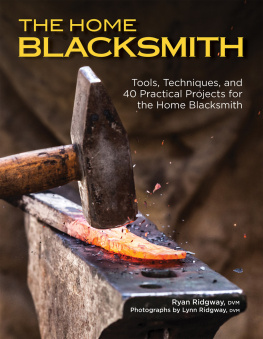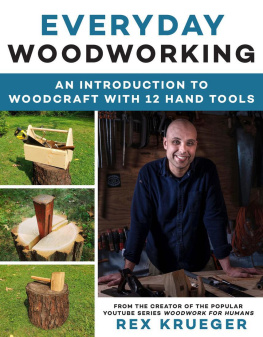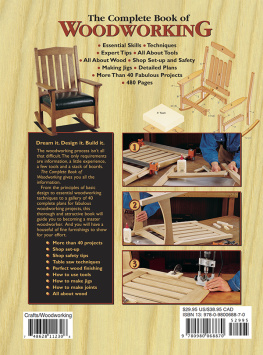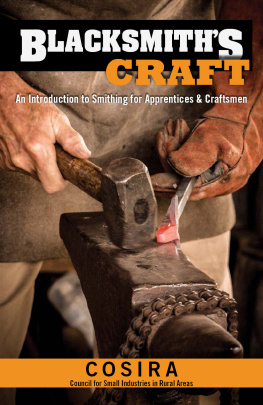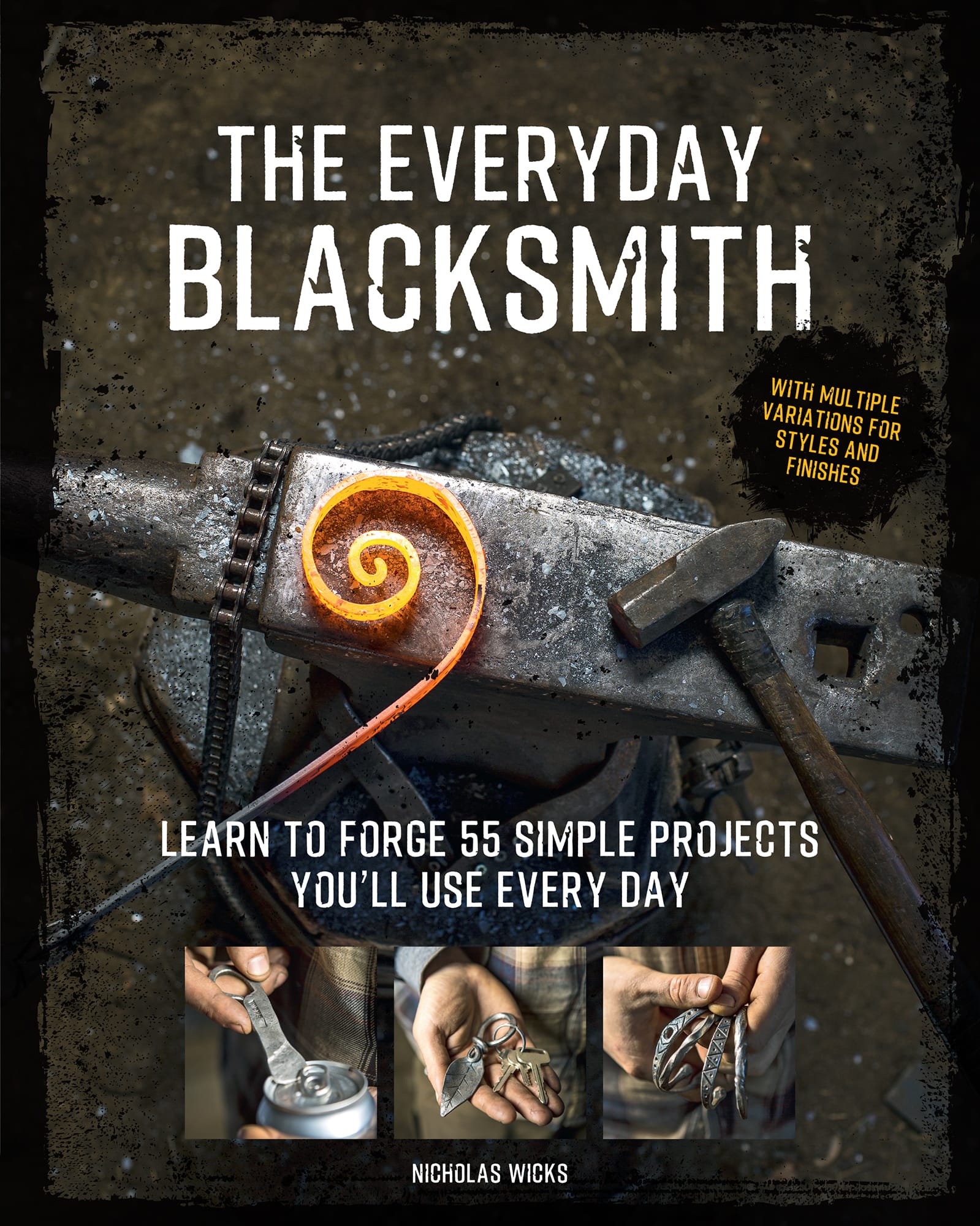BLACKSMITHING TODAY
A village blacksmith from the 1800s walking into todays blacksmith shop would find many familiar sights. The anvil, forge, hammers, tongs, and vise in the modern shop may even have been made during his time. He would see a kindred spirit in his modern counterpart, hunched over the anvil bringing a piece of hot iron to life with rhythmic blows of the hammer. What our village smith would not recognize would be the power toolswelders, drills, grinders, and power hammers that save the modern smith both time and sweat. Most of all, he might be surprised by the products of our modern smith and the blacksmiths evolving role in hisor her!community.
For centuries, blacksmiths were the craftsmen and artists who worked societys most important materialiron. The village blacksmith was the local hardware store, contractor, and mechanic all in onerecall, this was during the time of horses. Blacksmiths were not only a fixture in their community, they helped shape that community through their particular method of making the hinges, hooks, brackets, and tools their neighbors used every day.
In a twist of irony, the age of mass production that the blacksmith helped usher in almost led to the blacksmiths demise. Yet, instead of going the way of the dodo, blacksmithing today is enjoying a resurgence. Our modern society discovered that no amount of technical perfection replaced the feeling of picking up a hand-forged object and knowing someones creativity and effort went into shaping that particular piece. In makerspaces, art schools, blacksmith associations, modern shops, traditional smithies, online forums, and makeshift home forges, like-minded tinkerers have not only revived the craft, they are taking it in new and exciting directions.
Where do your interests lay? Traditionalists enjoy the history and culture of the craft and work mostly without modern power tools or electric welders. Artists and sculptors, drawn to the versatility and permanence of steel, explore the design limits of the material. Professional smiths are tasked with balancing an artistic bent within the architectural, functional, and financial constraints of commissioned projects and often combine traditional and modern techniques. Home smiths usually fall somewhere in between. They make pieces to use or sell while also dealing with constraints of time, space, funding, and equipment.
Many of these categories overlap. For example, in my limited years blacksmithing, Ive been a hobbyist in a home forge, an apprentice in a professional shop, a part-time blacksmith working out of a friends barn, and finally, owner of my own shop. In that time, I have been asked to make cannons and Samurai swords (jobs I sadly turned down) as well as traditional catapults and Nordic runes (jobs I couldnt refuse). Ive restored axes, designed custom gates, rebuilt truck beds, forged hand tools, furnished homes with hardware, created garden sculptures, and welded broken tractors parts. Many of these requests were things I didnt know could even be needed until a neighbor would call up and ask the always enchanting question that starts with can you make?
The beauty of blacksmithing is that answer, more often than not, is yes. For the world of steel is our domain. So let us return to our 1800s village blacksmith and ask this question: Is the part we play in our community today so different? We may not be repairing hammers or making nails for the local carpenter (actually, see the hardware chapter), but we blacksmiths continue to serve our community with the products of our craft. Honoring that tradition, I hope this book helps youlike our blacksmithing forebearscontinue to shape our world with unique pieces for yourselves, friends, neighbors, and community to use and enjoy every day.
This 100-year-old Champion coal forge was marketed to home smiths and farmers who needed to make and repair everyday items such as plowshares (the bade of a plow). Today, there is a resurgence of home smiths restoring these old tools and using them to make the next generation of everyday blacksmith goods.
BOOK STRUCTURE
T his book is divided into two parts. is a reference of shop basics: safety, equipment, and techniques. Basic techniques are illustrated through a series of projects. It also covers methods for finishing pieces.
, the majority of this book, provides a step-by-step guide to a diverse range of blacksmith projects. Projects are structured by category and difficulty. The emphasis of this book is on the accessibility of techniques, functionality of projects, and diversity of design. The projects selected for this book were ones that can be made, used, and enjoyed by folks in a variety of settings. With care, someone with only basic tools and equipment will be able to make every piece in this text. New techniques are explained the first time they appear in a project and are indexed for reference in the back of the book. There are many approaches to projects, influenced by available time, materials, tools, techniques, and ones aesthetics, and these pages represent only one of many ways to do things. Treat project steps as suggestions rather than scripture, and find out what works best for you.
Ive tried to account for the great diversity in our craft today by featuring projects by a range of smiths from several countries, up and coming and established, traditional and modern. Their stories are often as inspiring as their work. Look them up. As you will soon see, there are many exciting projects waiting for you to explore in the following pages. For newer smiths, I hope this book both teaches and motivates you as you continue on your journey in blacksmithing. For established smiths, I hope this book provides ideas, a launching pad, and timesaving when designing your own new products.
What are you waiting for? Get smithing!
PART I:
TOOLS AND TECHNIQUES
CHAPTER 1:
SETTING UP SHOP
T his section covers basic blacksmithing concepts. The emphasis is on helping you get started making the pieces in this book quickly. If you are brand new to smithing, it will be very helpful if you supplement this text with an additional reference on blacksmithing basics or take an introductory blacksmithing class. And if you are not already a member, consider joining a local or national blacksmithing association. These associations exist primarily to teach and help new smiths get into the craft. Many blacksmiths may be big and scruffy, but they are also friendly. We all learned our trade from generations before us, and most are happy to share with the next generation.
When setting up your shop, also known as a forge or smithy, there are certain immediate choices to make. This includes what type of fuel source to use and what basic tools to acquire or make. The pros and cons of various options are discussed as well as the range of tools useful for making all of the projects in this book. Blacksmiths are diverse. Depending on your interests, location, and budget, different setups may be right for you. You may not always know what you prefer until you try something outthats part of the adventure!


